- Details
- Written by HG
- Category: Strategy
- Hits: 2140
During 2024 a new word list, CSW2024, was published. This became effective January 1 2025.
Please note that some of the words and strategies discussed in this section prior to January 2025 may be affected by this new publication.
For example HENTAIS (SATINE + H) and RAPIEST (SATIRE + P)
- Details
- Written by HG
- Category: Strategy
- Hits: 3005
At the recent Coventry tournament Graham had an unusual end to the game.
Here is the board.
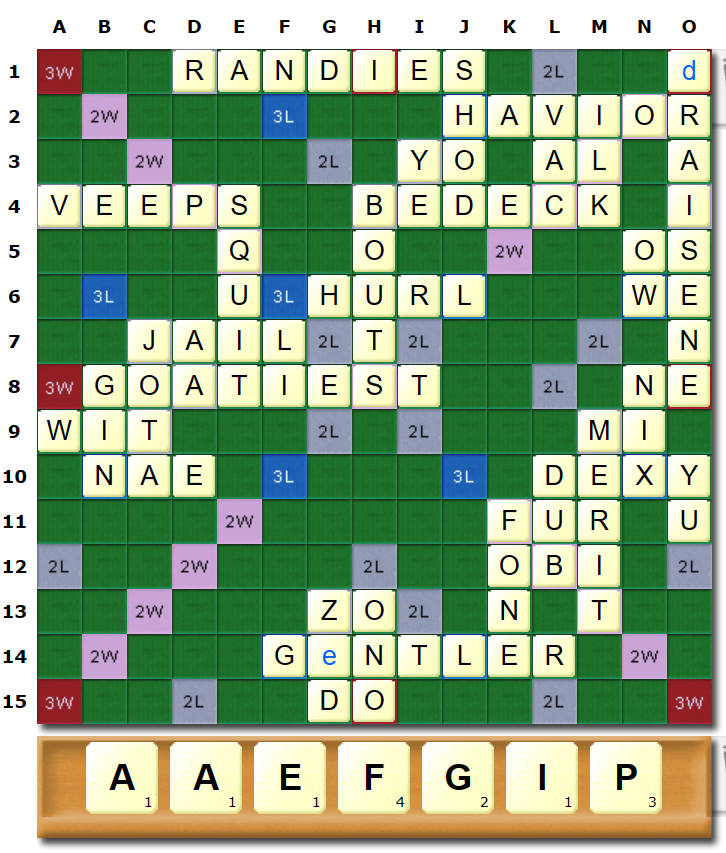
The scores are :
Graham 413 (rack AAEFGIP). Opponent 457 (with 3 letters C, M & R).
Graham to play, but can he win ? What is the highest score Graham can achieve ?
The first decision for Graham is … can my opponent play out next move? If he can, the game is lost.
Graham’s opponent has three consonants and needs at least one vowel to play any move. The only vowels allowing three consonants to be played are the Es in VEEPS (top left). In fact MERC or CREM are both playable. Therefore Graham’s next move MUST block both Es so that MERC and CREM cannot be played.
Graham has quite good letters for playing around or parallel to the Es – some sample moves include PEG c3 down (12) or FE c3down (10). The highest scoring block is EF b3 across scoring 22.
Before we choose a good blocking move, consider what our opponent can play thereafter, and whether we can get close to winning. There is only one vowel on the board that will allow our opponent to play two consonants (ERM c10 down scoring 10). Our opponent would do better playing consonants individually. The M could score 11 YUM 012 down, or MILK m1 down (10). The R will play as part of ER in a number of positions with the maximum being 4.
But what of our opponent’s C ? Closer inspection of the board would suggest that once CREM/MERC is blocked, the C is unplayable.
This means our opponent will have 2 scoring moves, and as long as Graham plays sensibly, he may be able to eke out a win.
Let us review some tentative scores :
Assuming our opponent plays YUM and ER they will score 15 giving a total of 472. They will lose 3 (unplayable C) so their total will be 469.
We would need to score 57 points to reach 470, of which 3 will be the value of our opponent’s C. So can we score 54 points with our letters ?
There are some nice scoring options on the board :
- Our blocking move, say PEG will score 12 (note if we play the highest scoring EF, our opponent can play CEE, which will defeat us)
- The I can be played for 11 (QI – e5)
- An A can be played making AG/AZO or ZOA/AT both scoring 15, but must be played LAST as both will enable the C to be played (CAG or CAT respectively)
- The F could score 10 K4, or 9 at G8 (subject to where our opponent’s R is played). Note : EF f9 across scores 21 providing our opponent doesn’t block it)
- AE f2 across scores11.
Playing PEG 12, QI 11, ZOA 15 (as last move), EF 9, AE 11 gives us 58 – enough to win… just!
Another method may be to play with EF (b4 down 5), then play GAVE (a2 down 13), then AGAVE (a1 down for 27), QI (11), followed by GIP (a2 across 12). This sequence of plays scores 68 more than enough to win!
Of course much depends on what our opponent plays, as it may mean some of our best plays are taken.
Taking this into account, and ‘assuming’ our opponent scores the MOST they can on any move Richard came up with the highest scoring solution thus :
|
Graham |
Graham total |
Opponent |
Opponent Total |
|
FA B3 across for 19 |
432 |
YUM O10 down for 11 |
468 |
|
YUMP O10 down for 11 |
443 |
FER B3 down for 6
|
474 |
|
TE/DOE at I14 down 6 |
449 |
Pass – unplayable C |
474 |
|
GOBI for 7 J12 across |
456 |
Pass |
|
|
QI at E5 across for 11 |
467 |
Pass |
|
|
ZOA/ATE at F13 across for 17 |
484 |
End of game |
|
|
Final scores +C |
487 |
-C |
471 |
A fantastic solution from Richard! Well done!
On closer inspection, if Graham or Graham’s opponent knew YUMPIE then playing YUIM 11 is a definite losing move as YUMPIE scores 39. Better to play MILK for 10.
Also we have assumed that our opponent played the R. It may be more tactical for our opponent to keep the R with the C, which will prevent Graham from playing an open A (yielding ARC/CAR) or E (REC). In the actual game this is what happened. Graham forgot the R, played an open A, and lost the game to ARC!
Summary :
It is frequently useful to block an opponents outplay if you can see it. Also if they have an unplayable tile, playing your remaining tiles relatively slowly may accrue enough points to seal the game!
Here is Richard's board :
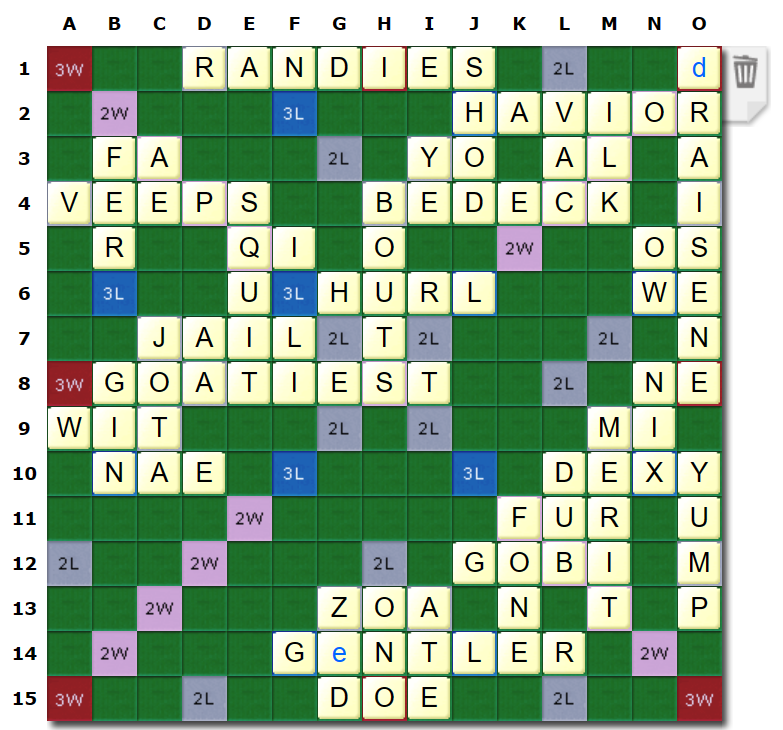
- Details
- Written by HG
- Category: Strategy
- Hits: 5030
Endgame Puzzle – Can Player A stop Player B from winning ?
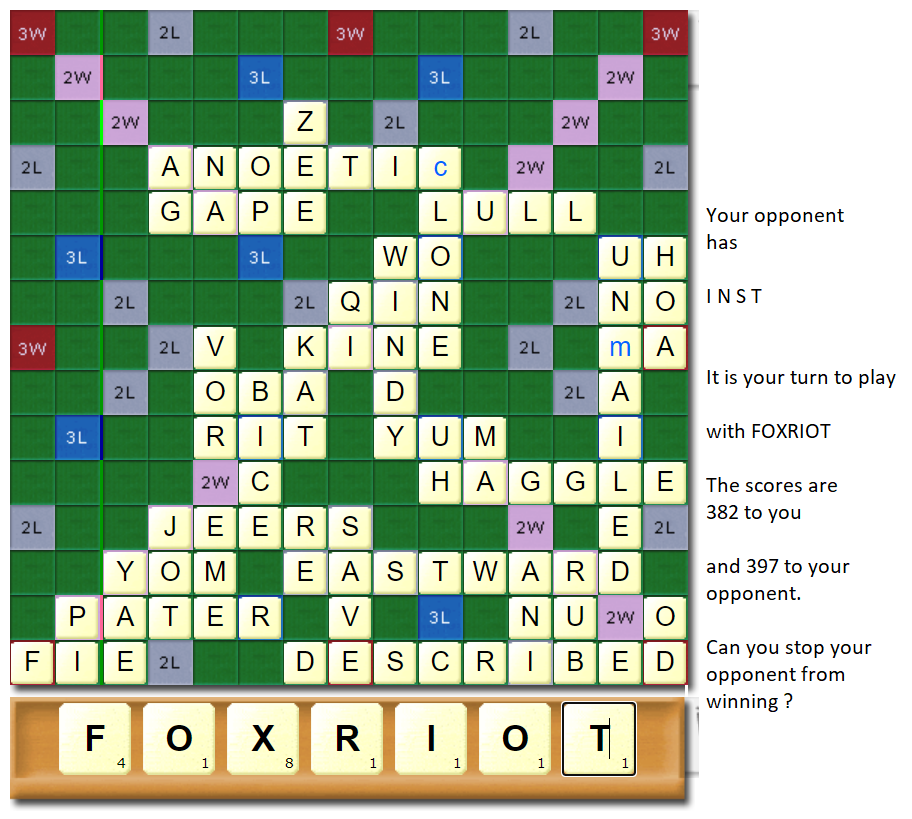
Player A rack FOXRIOT score 382 to play
Player B rack INST score 397.
It is Player A's turn. Can you see how Player B can win ? Can you stop it ?
Thoughts and analysis below.
On the first inspection, a 15 point gap holding an X should be a straightforward win for A. However B can play out on their next move in 3 places :
- Row 3 NITS or TINS making SAG (12 points)
- Row 5 NITS or TINS making AGS (10 points)
- Column L making LINTS (6 points).
Player A needs to score 15 points remove the deficit, another 6-12 points to outscore B’s play AND score enough to outscore the +/- of the remaining letters.
For example playing EX/EX in column 15 scores 34 points but leaves FORIOT (10 points) and doesn’t block B’s best play.
Thus the moves would go :
A : EX/EX 382 + 34 = 416
B : TINS/SAG 397 + 12 = 409 and out.
A : 416 – FORIOT (9) = 407.
B : 409 + FORIOT (9) = 418.
B wins by 11.
A similar result occurs if player A plays FAX/HOAX row 9.
Player A can’t block the AG (B’s highest scoring places) without enhancing B’s scoring.
Example OXO/AGO scores 16, but B can play TINS/SAGO.
Similarly RIFT/TAG by A, leaves B with TINS/TAGS.
But there is one move by A which will guarantee a minimum of a draw, and an outside chance of a win!!!!!
That is to play FIXT/TAG scoring 32. (A’s Total score is now 414 with ROO to be subtracted if B plays out, i.e 411 final score)
B’s best play is to play TINS/TAGS scoring 11 giving a total of 408 which with ROO to be added gives 411. A draw.
But what if B got greedy ?
The F of FIXT is two places below a triple word score, and SIFT scores a very reasonable 24.
It doesn’t finish the game so B would have a total of 421 (with an N left, so a final total of 420 assuming A plays out).
The score is now 414 for A, and 421 for B. A’s ROO will score well in column H making ROOT/ZO for 23 winning the game easily.
So in summary, if both players played to the best of their ability, the final score is a 411 draw !!!
- Details
- Written by HG
- Category: Strategy
- Hits: 3462
This board occurred at this year's Easter Warmup tournament.

You are player A with the rack A I I N O S T.
The scores are 397 to you and your opponent has 375. You have a healthy 22 point lead but…
Your opponent has only 6 tiles on their rack. You know that 3 of them are a J, a blank and an E, but you don’t have time to work out the remaining 3 tiles.
Can you win ?
Remember :
If you think your opponent can play all 6 tiles, you need to block their space or score more than their move will yield (also remembering to add/subtract your unplayed tiles).
If you think your opponent can’t play all 6 tiles, you will have the benefit of 2 moves to their 1 providing you can play 2 moves that outscore their move (and of course you will have the benefit of the +/- of their tiles).
You have a 22 point advantage to start with, so don’t forget to include that in your calculations.
In tournament play, you may not have time to calculate your opponent’s rack, but it should only take 5 minutes to help your decision-making.
There is one useful, but obscure, word which guarantees a win, but everyday Scrabbler’s vocabulary should see you winning… but how?
Answers / thoughts below
Coming soon
Real soon
Firstly if time permits player A should determine the letters in player B’s rack. This should only take a few minutes and are JAREL and a blank.
Secondly assess where the J can be played for a high scoring move.
There are 4 places :
1. Around the U or L in columns C/D and with the J on a double letter, and the whole word doubling. An example move JURAL would score 40 points, and if player B has a play out, using all 6 letters, will score 42 points (+/- points left on player A’s rack)
2. JiVE in row 14, this scores 32.
3. InJERA in column N for 28
4. JAiLED or JArREd in column N for 58.
Player B’s highest scoring moves are in column C and column N and cannot both be blocked.
What is player A’s highest scoring move ? The highest, and most obscure is ISATIN/GRIPES(30) and will leave an O.
This will mean player A will go 52 points up, and player B will lose if they play out for 42 points. So player B must play JAiLEd/JArRED for 58. Player B is now 6 points up, and all player A has to do is play the O to win and JO will do admirably.
But ISATIN is very obscure.
What is the next highest scoring move ?
There is another obscure word OSTIA (and GRIPES) for 27 and this will win in a similar manner to ISATIN.
There is an everyday word which scores 27 too. It also blocks player B’s high scoring words of InJERA, JiVe and JAiLED/JArRED. This word is VAIN in row 14. This will put player A 49 ahead.
Player B’s best score is 42 by playing out (7 points behind), and with player A holding OSTI, player B will win by 1 point.
If player B only plays JURAL (40), player A can play out with RIOTS column H for 18.
So playing ISATIN will win everytime. Playing VAIN will win providing there is no 6 letter word for player B to play out. There isn’t, so playing VAIN (blocking 3 out of 4 of the high J moves) will win, without resorting to knowing ISATIN.
In summary in a close game:
1 - Try to work out the tiles on your opponents rack
2 - Ascertain if they can play out in one move and either block it or score more than their move (allowing for +/- remainng tiles)
3 - if they can't play out in 1, you must try to play out in 2. and outscore their single move score (allowing for +/- remaining tiles).
- Details
- Written by HG
- Category: Strategy
- Hits: 5722
Here is a board towards the end of a game, and curiously many of the words have become all too familiar over the last few weeks.
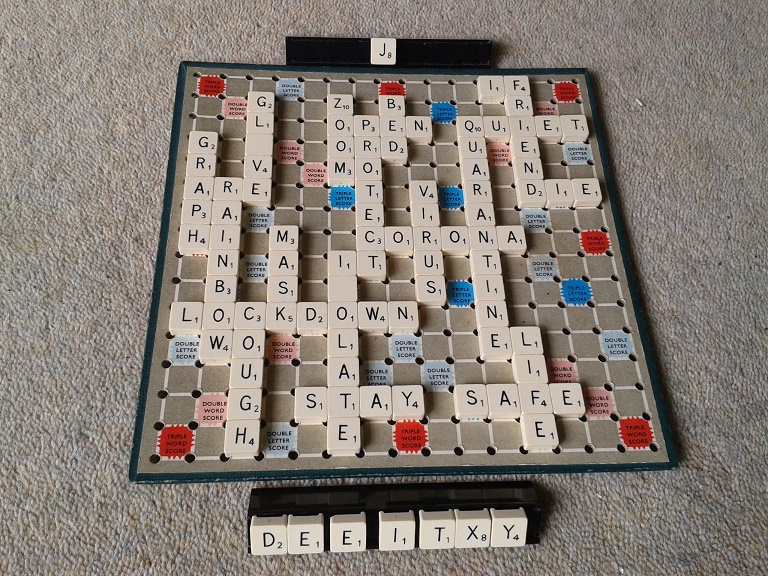
The two blanks are O - making GLOVE, and S making ISOLATE.
Your rack is DEEITXY. Your opponent has a J.
It is your turn to play, and you need to
- ascertain whether your opponent's J can play
- and, if it can, block the position
You then have to play your (remaining) tiles to accrue the highest score.
To do this you may decide to play off the tiles slowly.. or quickly.
Hint : Playing tiles slowly is likely to score you more points. For example playing YEH in the bottom left hand corner will score 27. But if you played EH for 5, then YEH for 27 you will score 32.
Can you score 80 or more points ? Is 100 points possible ? The words you lay needn't be in keeping with the theme of the puzzle.
.....
This puzzle was sent to East Berks Members late May 2020, with a week to find the highest outplay.
There were lots of very good plays on our coronavirus inspired board with everybody scoring 100 or at least close to. Well done!
The trick was blocking the J (onto the A of QUARANTINE)... but with what ?. YA or EA both do the trick as does AIN.
So its a matter of optimising the remaining 6 tiles making sure either Y, E or I is left.
Lots of players went for moves using h15 EXED, and several players also played YEH (a15) , some forgetting to play EH first!
The third best set of moves was from Mary - scoring 118. Well done Mary - here are her moves.
Move 1. AIN 5ka. 3 points
Move 2 EH 15ba. 5 points
Move 3 YEH. 15aa. 27 points
Move 4 EX 15fa. 18 points
Move 5 EXED 15fa 51 points
Move 6 TAX 13gd. 14 points
Mary was narrowly pipped by Wanda who utilised the Y and E in a different way to accrue 1 extra point (RAINBOWY and BEDE scored 33, to EH/YEH 32. Wanda's total was 119 !
AIN E11a 3
AX/EX N7d 18
AT/TAX M6a 14
EXED O6a 51
BEDE B8d 12
RAINBOWY F2d 21
But the winner is Richard who originally sent in the 118 score above, but then found a total of 126 by using the triple word score at O15, and building up the word YEXED.
Here are his words
1) Play the I at L5 to block the J and make AIN for 3.
2) Play the X at M15 making EX/EX for 18.
3) Play Y at K15 to make AY/YEX for 18.
4) Play T at M13 making IT/TEX for 24.
5) Play ED at N15a making YEXED for 48.
6) Play E at H15 making YE for 15.
Total 126
Well done Richard - a brilliant score which in a real game would involve a swing of 142 points (126 + 8 (J) , and your opponent would lose 8 points (J). Imagine being 140 points down and winning this game.
Here is his board :
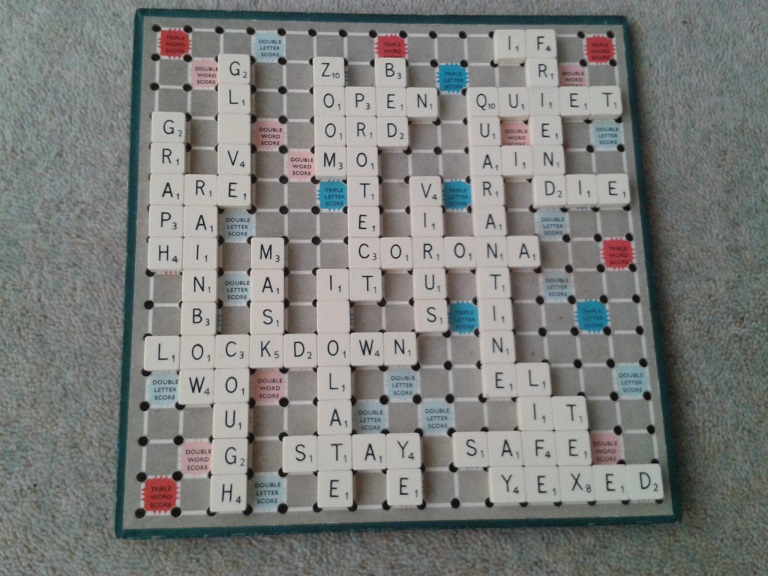
Page 1 of 5
